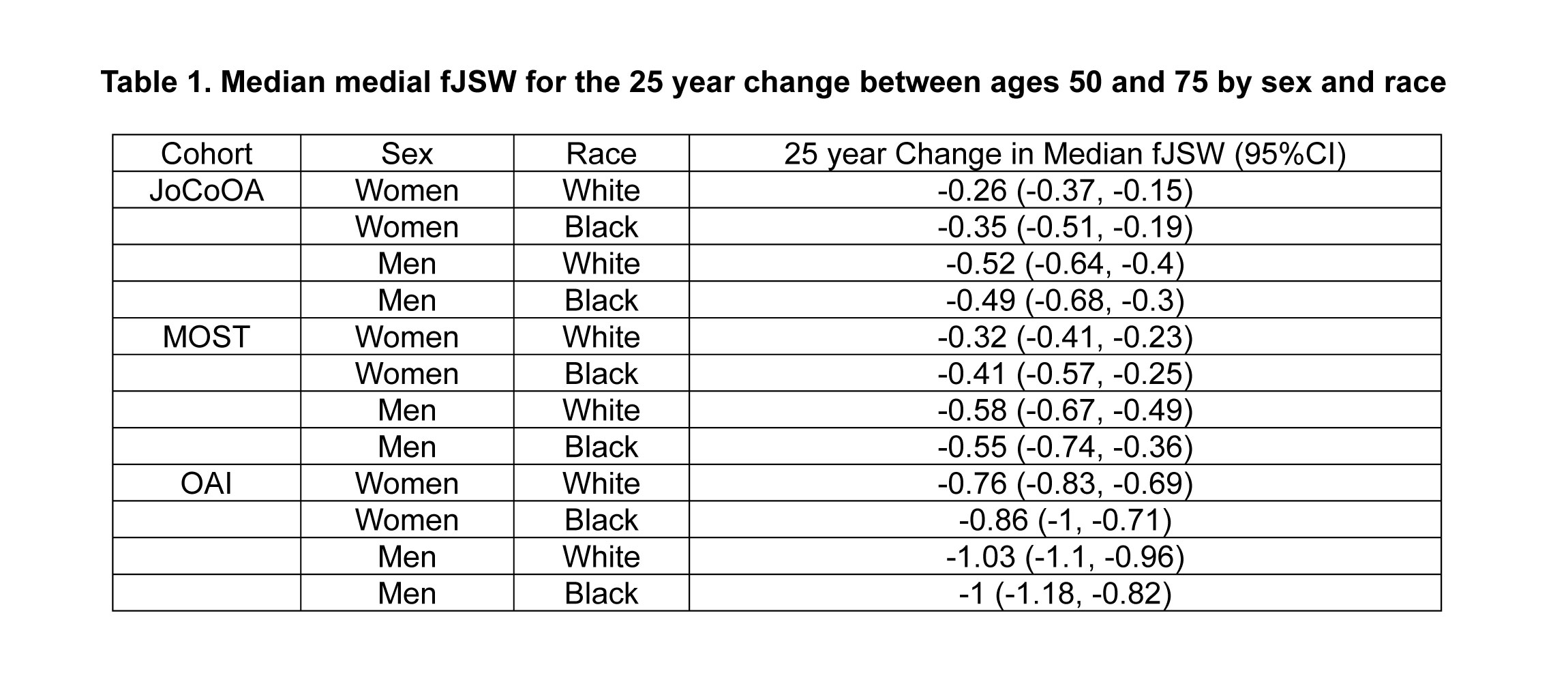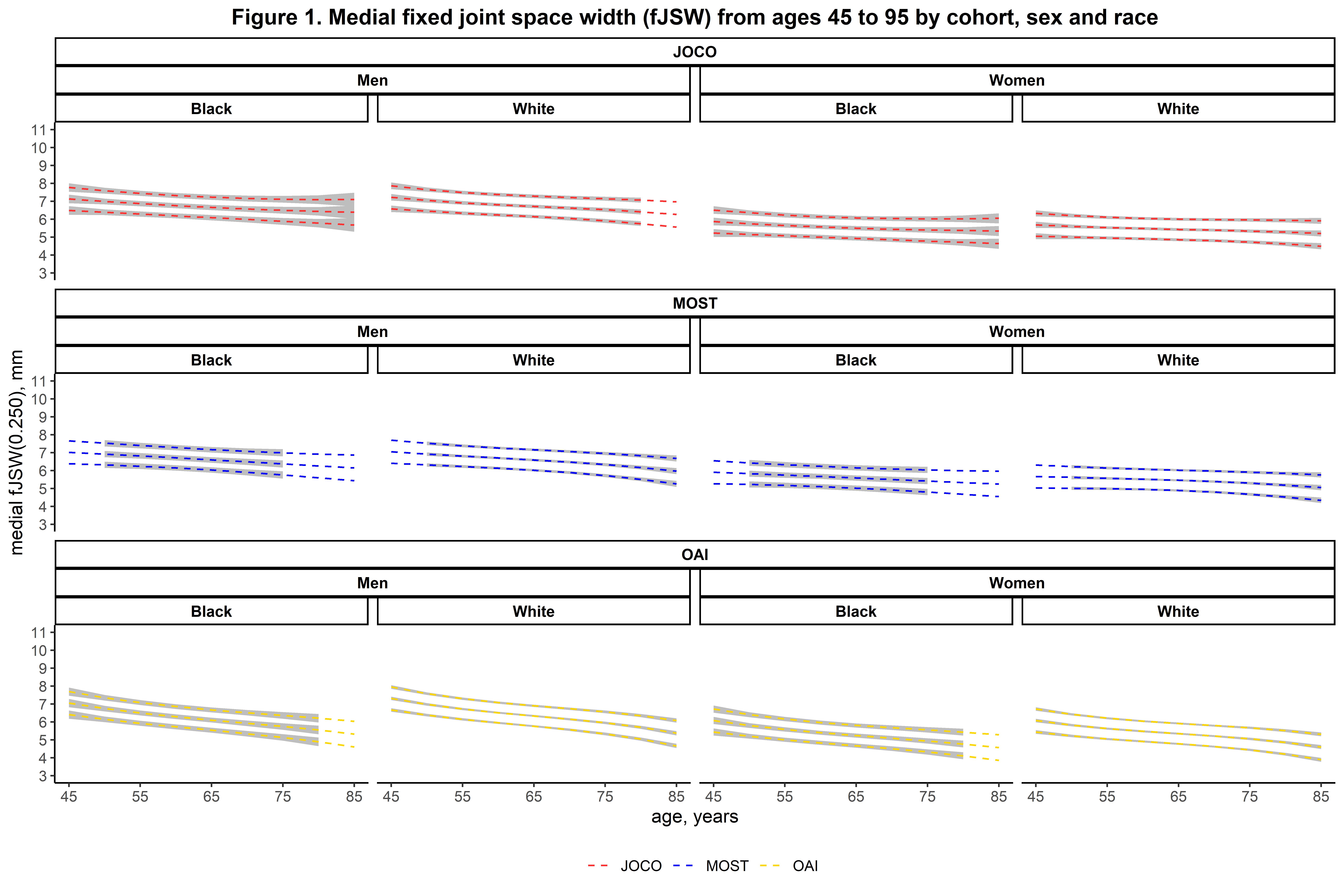Session Information
Session Type: Abstract Session
Session Time: 3:00PM-4:30PM
Background/Purpose: Quantitative radiographic joint space width (JSW) is often used as ameasure of structural outcomes in randomized controlled trials of knee OA (KOA). How JSW changes over time in healthy knees is not well-established; such insights would provide better understanding of the degree of change that may be expected as part of natural aging.Our objective was to examine sex- and race-specific distributions of medial fixed-location JSW (fJSW) among healthy knees across different ages in three cohorts.
Methods: Participants were selected from three longitudinal cohort studies: the Johnston County Osteoarthritis Project (JoCoOA), the Multicenter Osteoarthritis Study (MOST), and the Osteoarthritis Initiative (OAI). All participants underwent fixed flexion PA knee radiography at baseline and up to 7 of follow-up in MOST; 10 years in OAI; and 19 years in JoCoOA. The sample was limited to those with healthy knees which was defined as knees with no evidence of OA (i.e., Kellgren-Lawrence grade [KLG] 0) and without reported frequent knee pain (i.e., pain on more than half the days of the past 30 days) at the age at the time of assessment. We fit a linear mixed model for medial fJSW (x=0.250) with random effects for participants and knees within participants, fixed effects for age as a cubic polynomial, sex, race, cohort, all two-way interactions and a three-way interaction between cubic polynomial age, sex and race to examine potential heterogeneity among the three cohorts and differences by sex and race, where age was the metameter of time.
Results: The sample consisted of 4,541 participants who contributed 7,017 knees with at least one healthy timepoint, for a total of 23,995 healthy timepoint observations, including 2,346 from JoCoOA, 5,760 from MOST, and 15,889 from OAI. Participants self-identified as Non-Hispanic White (84%) and Black (16%), with a mean age of 61 (sd=9), and 57% reporting female sex, Table 1 illustrates the estimated 25-year change in the 50th percentile of medial fJSW between ages 50 and 75. Figure 1 shows the estimated 25th, 50th, and 75th percentiles and pointwise 95% confidence intervals of the medial fJSW from ages 45 to 95 stratified by sex and race for each cohort. Figure 2 shows the estimated 50th percentile of medial fJSW from ages 45 to 95 by sex and race for the three cohorts.
Conclusion: The natural history of medial fJSW among healthy knees is gradual loss with age among women and men and among Non-Hispanic White and Black participants. Heterogeneity of medial fJSW in healthy knees was observed at all ages between 45 and 89 years. Among healthy knees, on average, women had less fJSW than men across the spectrum of age, though women lose medial fJSW at a lower rate with age compared to men. We do not observe much difference in change on medial fJSW between races after controlling for study and sex for all 3 cohorts.
To cite this abstract in AMA style:
Kwoh K, Tang R, Ashbeck E, Bedrick E, Golightly Y, Nelson A, Neogi T, Ge Y, Li Z, Liew J, Sun X, Crawmer J, Duryea J. Sex and Race-Specific Distributions in Medial Fixed Joint Space Width in Healthy Knees from Three Longitudinal Cohorts [abstract]. Arthritis Rheumatol. 2024; 76 (suppl 9). https://acrabstracts.org/abstract/sex-and-race-specific-distributions-in-medial-fixed-joint-space-width-in-healthy-knees-from-three-longitudinal-cohorts/. Accessed .« Back to ACR Convergence 2024
ACR Meeting Abstracts - https://acrabstracts.org/abstract/sex-and-race-specific-distributions-in-medial-fixed-joint-space-width-in-healthy-knees-from-three-longitudinal-cohorts/



